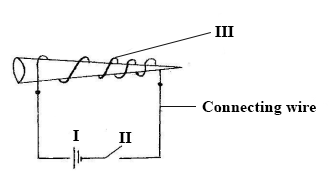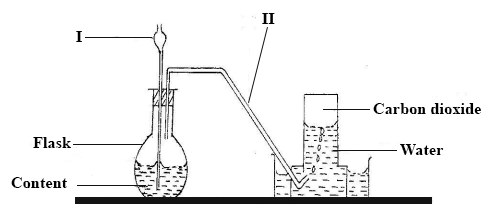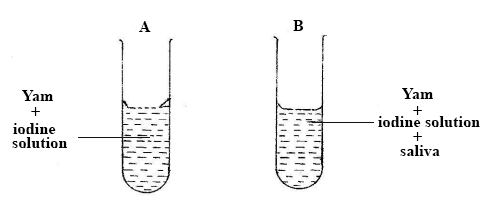1.
The property of a rock that makes it different from water is that it has
fixed volume.
fixed shape.
density.
mass
2.
A plane mirror can be described as opaque because it
absorbs all the light incident on it.
reflects all the light incident on it.
allows all the light incident on it to pass through it.
partly absorbs and partly allows the light incident on it to pass through it.
3.
Wood is used to make the handles of cooking utensils because it is
bad conductor of heat.
good absorber of heat.
good reflector of heat.
bad radiator of heat.
4.
Ventilation holes are made at the upper part of a door to allow air to rise by
convection.
conduction.
radiation.
reflection.
5.
When the north poles of two magnets are brought together they
attract each other.
repel each other.
first attract and then repel each other.
have no effect on each other.
6.
A fuse is used in an electrical circuit to
measure the energy used up.
protect appliances.
provide more current.
make sure current flows continuously.
7.
The angle between an incident ray and a reflecting surface is 20o. Determine the angle of reflection.
60o
70o
90o
110o
8.
A screw is a machine which works in the same way as
a lever.
an incline plane.
a wheel and axle.
a pulley.
9.
Power is defined as the rate at which
energy is used.
temperature rises.
a body travels.
a body cools down.
10.
An example of a lever in which the effort is applied at the middle is a
wheelbarrow.
pair of forceps.
pair of scissors.
beam balance.
11.
A simple way of maintaining the efficiency of a machine is by
oiling its parts.
fitting new parts on the machine.
making sure it is always working.
making sure it works at low speed.
12.
The part of a seed which grows to become the shoot of a plant is the
cotyledon.
plumule.
radicle.
testa.
13.
One disease that affects the nervous system of humans is
filariasis.
measles.
poliomyelitis.
typhoid
14.
Which of the following life processes leads to the release of energy?
Absorption of food
Digestion of food
Photosynthesis
Respiration
15.
Mineral salts in dead organisms are released into the soil by a process called
decomposition.
diffusion.
leaching.
osmosis.
16.
Spectacles fitted with concave lenses are worn by people suffering from
loss of accommodation.
total blindness.
long sightedness.
short sightedness.
17.
Which of these organs in humans releases carbon dioxide as a waste product?
Kidney
Liver
Lung
Skin
18.
Farmers do not plant the stems of maize because the stems
do not have buds.
are difficult to obtain.
dry up too quickly.
do not contain food.
19.
Which of the following ways of treating water makes the water soft?
Adding alum
Adding washing soda
Chlorinating
Filtering
20.
Water that needs a small amount of soap to form lather is described as
clean.
hard.
pure.
soft.
21.
Common salt (sodium chloride) is obtained from sea water by
condensation.
evaporation.
precipitation.
sublimation.
22.
The chemical formula of a compound describes the
ratio in which the elements are combined.
number of molecules in a compound.
nature of the bonding in the compound.
state of matter of the compound.
23.
Which of the following solvents can be used to remove grease from the hand?
Alcohol.
Palm kernel oil.
Turpentine.
Water.
24.
How many different elements are present in the compound H2SO4?
2
3
6
7
25.
Producers in an ecosystem are plants that
feed on other plants.
feed on dead materials.
manufacture their own food.
attract insects.
26.
The disease caused by the Plasmodium parasite is
Cholera.
malaria.
onchocerciasis.
schistosomiasis.
27.
Vaccination is carried out to
enable sores to heal faster.
increase the red blood cells of a person.
enable a person's white blood cells to fight against diseases.
kill germs in a person's body.
28.
Which of the following farming practices is likely to make the soil poor in nutrients?
Adding chemical fertilizer during each planting season
Planting cover crops on the land
Tilling the land before planting.
Burning the vegetation after clearing
29.
The type of cloud found closest to the earth's surface is
cirrus.
cumulus.
stratus.
stratocumulus
30.
The amount of water vapour in the atmosphere is called
fog.
humidity.
rain.
temperature.
31.
The planet which is farthest away from the sun is
Jupiter.
Mercury.
Mars.
Pluto
32.
Which of the following gases is involved in the process of rusting?
H2
Co2
O2
N2
33.
A non-reactive metal can be identified from other metals because its surface is
hard.
shiny.
smooth.
rough.
34.
The property of a metal that makes it possible for it to be drawn into a wire is called
conductivity.
ductility.
malleability.
resistivity.
35.
The main reason why food is processed is to make it
taste better.
preservable for a longer period.
possible to eat without cooking.
richer in nutrients.
36.
The process by which kerosene rises up to the wick of a lantern is known as
capillarity.
diffusion.
surface tension.
osmosis.
37.
Which of the following statements about friction is not true?
It wears off materials
It produces heat
It opposes motion
It increases speed
38.
Arteries are blood vessels which carry
blood to the heart.
carbon dioxide to the air.
blood away from the art.
oxygen to the lungs.
39.
Which of the following structures is not involved in blood circulation?
Capillary
Heart
Muscle
vein
40.
A substance of mass 10 kg has a density of 2.0 kgm-3. Calculate its volume.
0.2 m3
5.0 m3
10.0 m3
20.0 m3
(a)
The diagram below shows the electrical method of magnetizing a nail.
Study the diagram and use it to answer the questions that follow.

(i)
Give the names of the parts of the circuit labelled I, II and III.
(ii)
List two substances that can be made into a magnet.
(iii)
State two other methods of making magnets.
(iv)
Name one material that is used in making an electrical wire.
(v)
Give two properties of the material you named in (iv) which makes it useful as a wire.
(b)
The diagram below shows the set-up for the preparation of carbon dioxide in the laboratory.

(i)
Name the parts of the set-up labelled I and II.
(ii)
Give the name of the method of gas collection shown in the diagram.
(iii)
Give one property of gases collected over water.
(iv)
What will happen if component I does not dip into the contents of the flask?
(v)
List two compounds that form the content of the flask.
(vi)
Write down the systematic name of carbon dioxide.
(c)

In an experiment, yam pap is put into two test tubes A and B containing iodine solution.
The test tubes are warmed slightly to a temperature of 37oC and saliva is put into test tube B.
(i)
State the colour of the content of the test tube A.
(ii)
State the colour changes of the contents in test tube B after 3 minutes.
(iii)
Fehling's solution is added to the contents of test tube B after the 3 minutes and it turns brick-red. What food substance is present?
(iv)
Give two functions of saliva in eating.
(v)
Why was it necessary to warm the contents of the test tubes to about 37oC?
(vi)
Give two aims of the experiment.
(a)
(i)
State two conditions that are required for photosynthesis to take place.
(ii)
How would you show that starch is formed during photosynthesis?
(b)
Write a balanced chemical equation to show the reaction between hydrogen and oxygen.
(c)
(i)
What is a satellite?
(ii)
Give one example of a natural satellite.
(iii)
List two uses of artificial satellites.
(a)
Define
(i)
self-pollination
(ii)
cross-pollination
(b)
State two ways in which cross-pollinated plants are better than self-pollinated plants.
(c)
Sodium chloride is prepared by the reaction between dilute hydrochloric acid and sodium hydroxide.
(i)
Write a balanced equation for the reaction.
(ii)
What is the name given to this reaction?
(d)
Describe an experiment to show that pressure acts in all directions in a liquid.
(a)
(i)
What is a vector of a disease?
(ii)
State two methods each by which the vectors of the following diseases can be destroyed:
(α)
river blindness;
(β)
malaria.
(b)
Write down the systematic names of the following compounds:
(i)
CaCo3;
(ii)
FeS;
(iii)
NaCl;
(iv)
NaOH.
(c)
(i)
Give the two properties that are common to all states of matter.
(ii)
In an experiment to determine the density, a stone of mass 60 g is put into a bowl containing water. If the level of the water rises from 60 cm3 to 75 cm3, determine the density of the stone.
(a)
Mention five differences between plants and animals.
(b)
Define each of the following terms, giving one example in each case:
(i)
Compound;
(ii)
Element.
(c)
(i)
Give two differences between an electrical insulator and a conductor.
(ii)
Draw and label a simple electrical circuit made up of a cell and a switch connected to two electric bulbs connected in parallel.